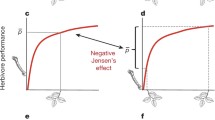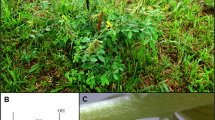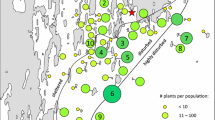Abstract
In the attempt to use results from small-scale studies to make large-scale predictions, it is critical that we take into account the greater spatial heterogeneity encountered at larger spatial scales. An important component of this heterogeneity is variation in plant quality, which can have a profound influence on herbivore population dynamics. This influence is particularly relevant when we consider that the strength of density dependence can vary among host plants and that the strength of density dependence determines the difference between exponential and density- dependent growth. Here, we present some simple models and analyses designed to examine the impact of variable plant quality on the dynamics of insect herbivore populations, and specifically the consequences of variation in the strength of density dependence among host plants. We show that average values of herbivore population growth parameters, calculated from plants that vary in quality, do not predict overall population growth. Furthermore, we illustrate that the quality of a few individual plants within a larger plant population can dominate herbivore population growth. Our results demonstrate that ignoring spatial heterogeneity that exists in herbivore population growth on plants that differ in quality can lead to a misunderstanding of the mechanisms that underlie population dynamics.






Similar content being viewed by others
References
Abrahamson WG, Weis AE (1997) Evolutionary ecology across three trophic levels. Princeton University Press, Princeton
Belovsky GE, Joern A (1995) Regulation of rangeland grasshoppers: differing dominant mechanisms in space and time. In: Cappuccino N, Price PW (eds) Population dynamics: new approaches and synthesis. Academic, San Diego, pp 359–386
Berryman AA (1999) Principles of population dynamics and their application. Stanley Thornes Publishers, Cheltenham
Clark JS (2003) Uncertainty and variability in demography and population growth: a hierarchical approach. Ecology 84:1370–1381
Denno RF, McClure MS (eds) (1983) Variable plants and herbivores in natural and managed systems. Academic, New York
Denno RF, McClure MS, Ott JR (1995) Interspecific interactions in phytophagous insects: competition reexamined and resurrected. Annu Rev Entomol 40:297–331
Forrester GE, Steele MA (2004) Predators, prey refuges, and the spatial scaling of density-dependent prey mortality. Ecology 85:1332–1342
Foster MA, Schultz JC, Hunter MD (1992) Modeling gypsy moth-virus-leaf chemistry interactions: implications of plant quality for pest and pathogen dynamics. J Anim Ecol 61:509–520
Freedman HI, Waltman P (1977) Mathematical models of population interactions with dispersal. I: stability of two habitats with and without a predator. SIAM J Appl Math 32:631–648
Gilpin ME, Hanski I (1991) Metapopulation dynamics: empirical and theoretical investigations. Academic, London
Groeters FR (1989) Geographic and clonal variation in the milkweed-oleander aphid, Aphis nerii (Homoptera: Aphididae), for winged morph production, life-history, and morphology in relation to host plant permanence. Evol Ecol 3:327–341
Hassell MP, Southwood TRE, Reader PM (1987) The dynamics of the viburnum whitefly (Aleurotrachelus jelinekii): a case study of population regulation. J Anim Ecol 56:283–300
Hastings AH (1993) Complex interactions between dispersal and dynamics: lessons from coupled logistic equations. Ecology 74:1362–1372
Helms SE, Connelly SJ, Hunter MD (2004) Effects of variation in plant species on the interaction between an herbivore and its parasitoid. Ecol Entomol 29:44–51
Holt RD (1985) Population dynamics in two-patch environments: some anomalous consequences of an optimal habitat distribution. Theor Pop Biol 28:181–208
Hunter MD (2001) Multiple approaches to estimating the relative importance of top- down and bottom-up forces on insect populations: experiments, life tables, and time-series analysis. Basic Appl Ecol 2:295–309
Hunter MD, Malcolm SB, Hartly SE (1996) Population-level variation in plant secondary chemistry, and the population biology of herbivores. Chemoecology 7:45–56
Hunter MD, Forkner RE, McNeil JN (2000) Heterogeneity in plant quality and its impact on the population ecology of insect herbivores. In: Hutchings MA, John EA, Stewart AJA (eds) The ecological consequences of environmental heterogeneity. Blackwell, Oxford, pp 155–179
Inouye BD (2005) Scaling up from local competition to regional coexistence across two scales of spatial heterogeneity: insect larvae in the fruits of Apeiba membranacea. Oecologia. DOI 10.1007/s00442-005-0059-7
Jones RE, Nealis VG, Ives PM, Scheermeyer E (1987) Seasonal and spatial variation in juvenile survival of the cabbage butterfly Pieris rapae: evidence for patchy density dependence. J Anim Ecol 56:723–737
Larsson S, Ekbom B, Bjorkman C (2000) Influence of plant quality on pine sawfly population dynamics. Oikos 89:440–450
Lill JT, Marquis RJ, Ricklefs RE (2002) Host plants influence parasitism of forest caterpillars. Nature 417:170–173
McIntyre PJ, Whitham TG (2003) Plant genotype affects long-term herbivore population dynamics and extinction: conservation implications. Ecology 84:311–322
Melbourne BA, Chesson P (2005) Scaling up population dynamics: integrating theory and data. Oecologia. DOI 10.1007/s00442-005-0058-8
Price PW, Bouton CE, Gross P, McPheron BA, Thompson JN, Weis AE (1980) Interactions among three trophic levels: influence of plants on interactions between insect herbivores and natural enemies. Annu Rev Ecol Syst 11:41–65
Pulliam HR (1988) Sources, sinks, and population regulation. Am Nat 132:652–661
Rossiter MC (1994) Maternal effects hypothesis of herbivore outbreak. Bioscience 44:752–763
Rotem KA, Agrawal AA (2003) Density dependent population growth of the two- spotted spider mite, Tetranychus urticae, on the host plant Leonurus cardiaca. Oikos 103:559–565
SAS (1999) SAS/STATS user’s guide. SAS Institute, Cary
Sauer JR, Link WA (2002) Hierarchical modeling of population stability and species group attributes from survey data. Ecology 83:1743–1751
Shima JS, Osenberg CW (2003) Cryptic density dependence: effects of covariation between density and site quality in reef fish. Ecology 84:46–52
Southwood TRE, Hassell MP, Reader PM, Rogers DJ (1989) Population dynamics of the viburnum whitefly (Aleurotrachelus jelinekii). J Anim Ecol 58:921–942
Spiegelhalter DJ, Thomas A, Best NG (1999) WinBUGS, Version 1 2, user manual. MRC Biostatistics Unit
Underwood N (2004) Variance and skew of the distribution of plant quality influence herbivore population dynamics. Ecology 85:686–693
Underwood N, Rausher M (2000) The effects of host-plant genotype on herbivore population dynamics. Ecology 81:1565–1576
Underwood N, Rausher M (2002) Comparing the consequences of induced and constitutive plant resistance for herbivore population dynamics. Am Nat 160:20–30
Acknowledgements
We thank Jeff Diez, Ron Pulliam, Pejman Rohani, Caralyn Zehnder, and Chris Frost for discussion and comments on the manuscript. This work was supported by NSF grant DEB-9906366 to MDH. We thank two anonymous reviewers for constructive criticism of an early version of this manuscript.
Author information
Authors and Affiliations
Corresponding author
Additional information
Communicated by Craig Osenberg
Rights and permissions
About this article
Cite this article
Helms, S.E., Hunter, M.D. Variation in plant quality and the population dynamics of herbivores: there is nothing average about aphids. Oecologia 145, 196–203 (2005). https://doi.org/10.1007/s00442-005-0060-1
Received:
Accepted:
Published:
Issue Date:
DOI: https://doi.org/10.1007/s00442-005-0060-1




